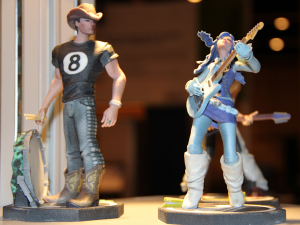Toys /
Toy Collecting
3D Printing – This Time Your Action Figure Is for Real
By Hervé St-Louis
September 9, 2012 - 16:35
 |
| Source: netfabb GmbH |
3D printing is the next craze, bigger than mobile. And it’s coming very soon. Consumer-level 3D printers can already be bought for less than $2000 and the plastic material needed to print a model, like an action figure is cheaper than the ink from a inkjet or laser printer. Yet 3D printing faces a host of challenges, mostly related to copyrights and the resistance of existing companies that manufacture stuff to allow users to make their own toys.
By toys, I mean not just action figures, but anything you would like to build. It could be a replacement case for your smartphone, or a new complete box casing for your actual phone. It could be a new bumper for your Honda Civic or a new shell for the television monitor’s frame that was damaged the last time you moved. 3D printing depends on the availability of 3D models and that’s where the problems begin. There are a few way to build 3D models. You can scan an existing object with a 3D scanner, the same way you would scan the page of a comic book. You could build a model yourself, using a 3D modeling program like Rhino or Cinema4D. Or you could somehow obtain access to the industrial model built in something like SolidWorks used by a manufacturer to build an object. For example, if you could get your hand on the SolidWorks model of a Samsung Galaxy, you know, if such a thing was ever leaked, with the right prototyping 3D printer, you could build the full casing of your smartphone exactly as it was designed by Samsung.
Soon, the same way music lovers easily have access to music tracks online, scanlation of comic books or the latest Hollywood blockbuster, average users will have access to a plethora of 3D models of common objects to replace parts of their cars, their phones, tables, computers, cutlery, toys, remote controls and so on. However, the right to use these models will be viciously guarded by manufacturers, as
BoingBoing’s Cory Doctorow argues frequently.
 |
| Source: netfabb GmbH |
3D printing is not yet affordable to the masses but the skills needed to master the technique are easy to learn. But the average consumer will not even have to learn how to clean up and manipulate a model in Rhino3D. I bet Chinese or Indian second market providers will be ready to take 3D prints from outsourcing manufacturers building the latest goods in China and the rest of Asia and will start making mock products for sale. It’s already happening in a way. For example, for years, Hasbro’s G.I. Joe moulds were copied and reused by merchants in Mexico to make lower grade G.I. Joe action figures. If they had their hands on those models, the figures would look much better. When one travels to Hong Kong, there is a grey market for fake products that look much like the real thing. All it takes is a few enterprising and unscrupulous operators to steal 3D models from say Apple and they can start replicating iPhones.
What 3D printing offers is an opportunity for consumers to be involved in the process of producing the goods they consume. Hobbyists will be the first to take advantage of 3d printing. They will be the ones producing limited runs of custom action figures of their favourite super heroes. They will be the ones recruiting local artists to airbrush their action figures and sand them smoothly. They’ll be hiring local designers to create neat packaging for their products. Some will be more enterprising than others. One of them will start creating an assemble yourself futon bed made of plastics. At once this will encourage the local artisans to hunt their local thrift stores for fabrics to create cushions in delectable patterns. That’s what I really hope 3D printing will do. Instead of buying stuff from overseas, we’ll be buying unique piece of furniture and action figures from local modellers who work with local artisans to reuse older materials and combine them with the plastic materials used as the core of a new bunch of unique products.
I look forward to that specific future of 3D printing more, than I do with the DRM one where police detectives will crack open people’s computers looking for the copies of bootlegged 3D designs of the latest iPad.
Last Updated: March 3, 2025 - 20:40

